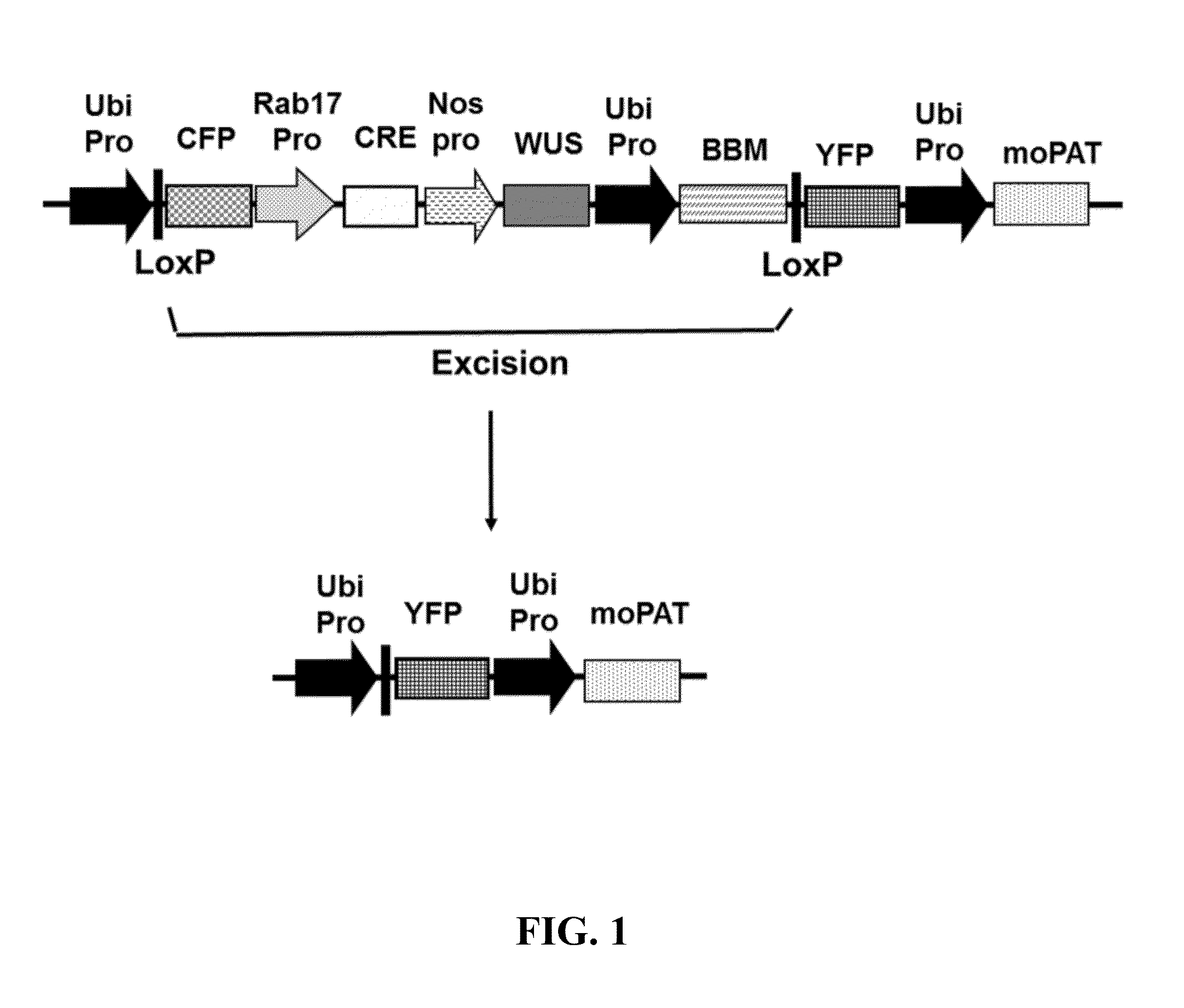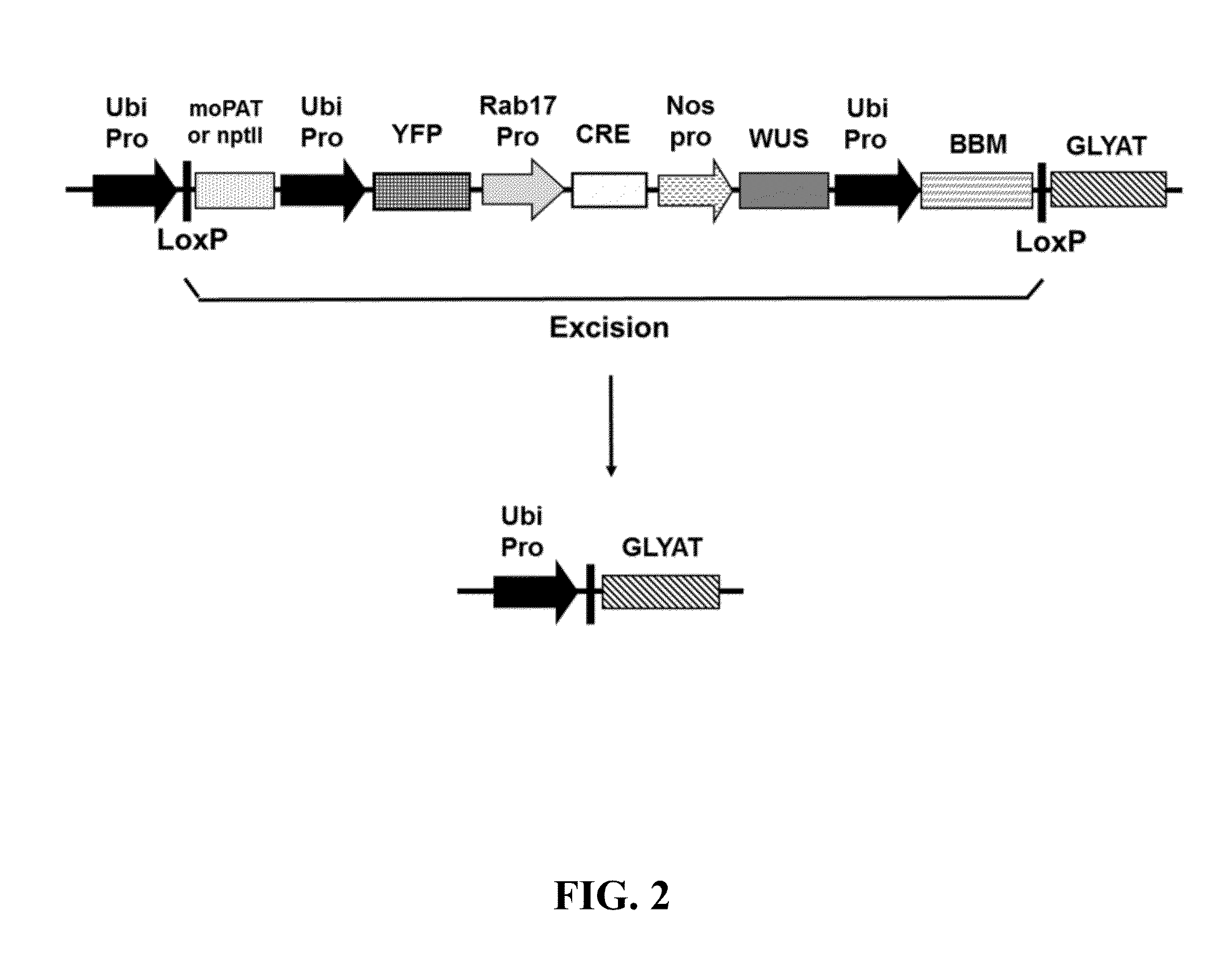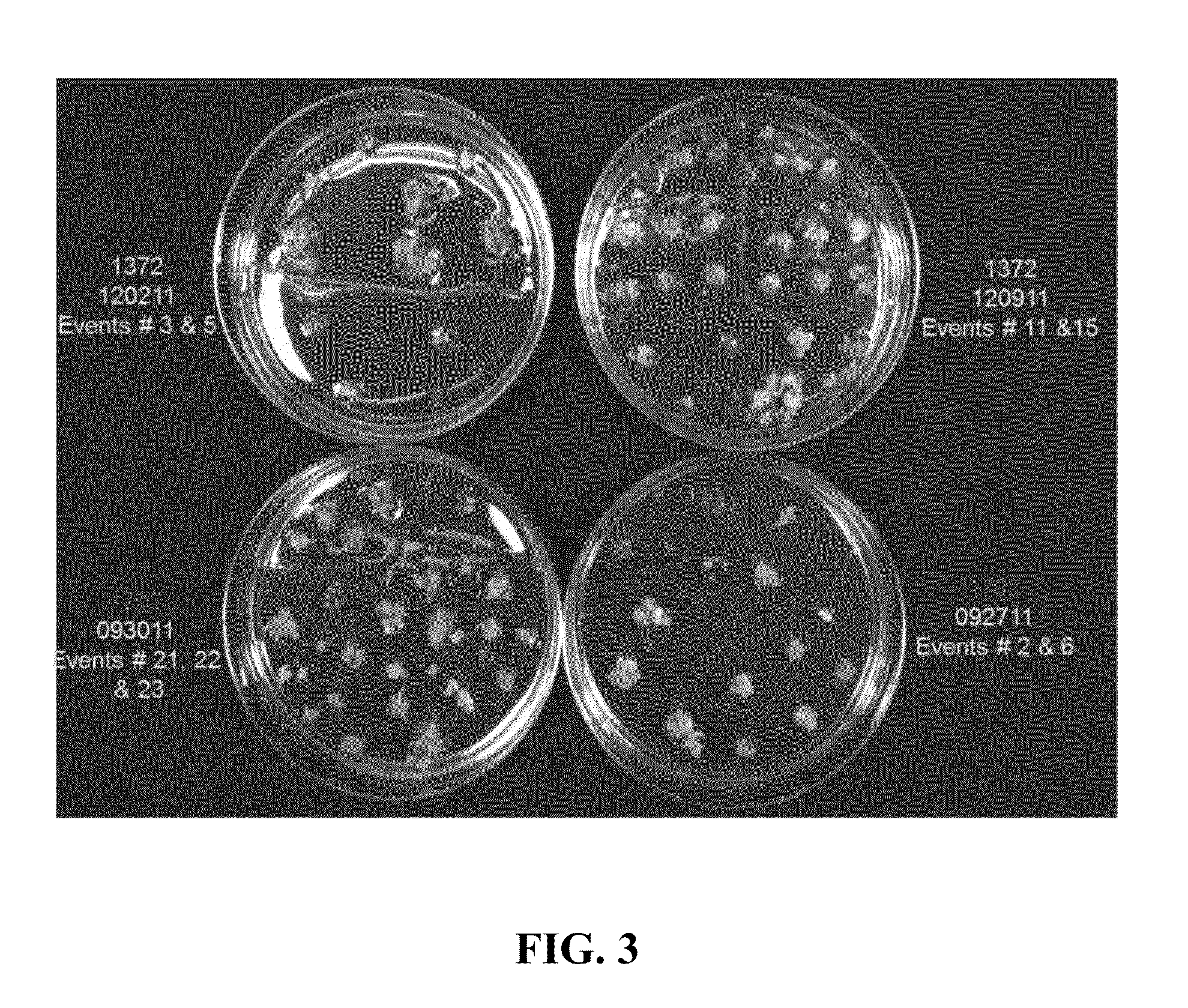Methods and compositions for producing and selecting transgenic plants
a technology of transgenic plants and compositions, applied in the field of gene modification of plants, can solve the problems of inefficient direct selection of herbicides, such as glyphosate and sulfonylurea, during the early stages of transgenic plant production (i.e. tissue proliferation), and achieve the effect of reducing the transformation frequency of plants and preventing the expression of transgenes
- Summary
- Abstract
- Description
- Claims
- Application Information
AI Technical Summary
Benefits of technology
Problems solved by technology
Method used
Image
Examples
example 1
Glyphosate Selection of Transformed Maize Inbred PHR03
[0509]Immature embryos from maize inbred PHR03 were harvested 9-13 days post-pollination with embryo sizes ranging from 0.8-2.5 mm length and were co-cultivated with Agrobacterium strain LBA4404 containing the vector PHP29204 or Agrobacterium strain LBA4404 containing the vector PHP32269 on PHI-T medium for 2-4 days in dark conditions. PHP29204: Ubi:DsRed+Ubi:GAT4602. PHP32269: Ubi:PMI+Ubi:MOPAT::YFP. Ubi refers to the maize ubiquitin promoter (UBI1ZM PRO; SEQ ID NO: 111), the ubiquitin 5′ UTR (UBI1ZM 5UTR; SEQ ID NO: 112), and ubiquitin intron 1 (UBIZM INTRON1; SEQ ID NO: 113). The tissues were then transferred to DBC3 medium without selection for one week, and then to DBC3 medium with 0.25 mM or 0.5 mM glyphosate for 3 weeks, and then DBC3 medium with 0.5 mM glyphosate for another 3-4 weeks. The embryos were then transferred to PHI-RF maturation medium with 0.1 mM glyphosate for 2-3 weeks until shoots formed, at which point, th...
example 2
Agrobacterium-Mediated Sugarcane Transformation Using a Standard Test Vector without Developmental Genes
Media for Plant Transformation:
[0513]Liquid DBC3(M5G) contains MS salts (4.3 g / L) plus maltose (30 g / L); glucose (5 g / L); thiamine-HCl (1 mg / mL); myo-inositol (0.25 g / L); N—Z-amine-A (casein hydrolysate) (1 g / L); proline (0.69 g / L); CuSO4 (4.9 μM); 2,4-D (1.0 mg / L); BAP (0.5 mg / L); Adjust volume to 1 L with ddH2O; pH 5.8—Adjust pH with 1 M KOH; autoclave.
[0514]DBC3 contains MS salts (4.3 g / L) plus maltose (30 g / L); thiamine-HCl (1 mg / mL); myo-inositol (0.25 g / L); N—Z-amine-A (casein hydrolysate) (1 g / L); proline (0.69 g / L); CuSO4 (4.9 μM); 2,4-D (1.0 mg / L); BAP (0.5 mg / L); Adjust volume to 1 L with ddH2O; pH 5.8—Adjust pH with 1 M KOH; Phytagel (3.5 g / L); autoclave.
[0515]DBC6 contains MS salts (4.3 g / L) plus maltose (30 g / L); thiamine-HCl (1 mg / mL); myo-inositol (0.25 g / L); N—Z-amine-A (casein hydrolysate) (1 g / L); proline (0.69 g / L); CuSO4 (4.9 μM); 2,4-D (0.5 mg / L); BAP (2.0 mg / ...
example 3
Sugarcane Transformation Using a Developmental Gene (DevGene) Vector PHP35648 and Excision Test
[0522]A DevGene binary vector (PHP35648, FIG. 1) with the BBM / WUS gene cassette was initially compared with a standard vector containing PAT or moPAT plus DsRED without the BBM / WUS gene cassette for transformation frequency using two Agrobacterium strains, AGL1 and LBA4404, in cultivar CP89-2376 and the recalcitrant cultivar CP01-1372 (Table 6). The DevGene binary vector contains Ubi::LoxP::CFP+Rab17Pro-attb1::Cre+Nos::ZmWUS2+Ubi::ZmBBM-LoxP::YFP+Ubi::MOPAT (FIG. 1); each gene cassette has a 3′ terminator. The Lox cassette containing CFP::Cre::WUS::BBM can be excised by Cre recombinase controlled by the Rab17 promoter. The PHP35648 vector was designed to demonstrate the excision efficiency of the excision cassette using visual markers. The PHP35648 excision cassette comprises the cyan fluorescent protein (CFP) controlled by the ubiquitin promoter (comprising the maize ubiquitin promoter (U...
PUM
| Property | Measurement | Unit |
|---|---|---|
| stress- | aaaaa | aaaaa |
| chemical- | aaaaa | aaaaa |
| chemical-inducible | aaaaa | aaaaa |
Abstract
Description
Claims
Application Information
 Login to View More
Login to View More - R&D
- Intellectual Property
- Life Sciences
- Materials
- Tech Scout
- Unparalleled Data Quality
- Higher Quality Content
- 60% Fewer Hallucinations
Browse by: Latest US Patents, China's latest patents, Technical Efficacy Thesaurus, Application Domain, Technology Topic, Popular Technical Reports.
© 2025 PatSnap. All rights reserved.Legal|Privacy policy|Modern Slavery Act Transparency Statement|Sitemap|About US| Contact US: help@patsnap.com



